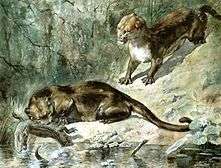Oxyaenidae
| Oxyaenidae Temporal range: Middle Paleocene to late Eocene 60.2–33.9 Ma | |
|---|---|
 | |
| Part of a Palaeonictis occidentalis skull at the Museum für Naturkunde, Berlin | |
| Scientific classification | |
| Kingdom: | Animalia |
| Phylum: | Chordata |
| Class: | Mammalia |
| Superorder: | Laurasiatheria |
| Family: | †Oxyaenidae Cope, 1877 |
| Subfamilies | |
|
†Ambloctoninae | |
Oxyaenidae is a family of carnivorous mammals. Traditionally classified in the wastebasket taxon Creodonta, they are actually unrelated to other clades within that order, and are basal laurasiatheres. The group contains three subfamilies comprising ten genera.
North American oxyaenids were the first creodonts to appear during the late Paleocene, while smaller radiations of oxyaenids in Europe and Asia occurred during the Eocene.[1] They were superficially cat-like beasts that walked on flat feet, in contrast to modern cats, which walk or run on their toes. Anatomically, characteristic features include a short, broad skull, deep jaws, and teeth designed for crushing rather than shearing, as in the hyaenodonts or modern cats.(Lambert, 163)
Oxyaenids were specialized carnivores that preyed on other terrestrial vertebrates, eggs and insects. They were capable of climbing trees, which is suggested by fossil evidence of their paws.
Taxonomy

- ORDER CREODONTA creodonts
- Family Oxyaenidae
- Subfamily Ambloctoninae
- Genus Ambloctonus
- Genus Dipsalodon
- Genus Dormaalodon
- Genus Palaeonictis
- Subfamily Oxyaeninae
- Genus Dipsalidictis
- Genus Malfelis
- Genus Oxyaena
- Genus Patriofelis
- Genus Protopsalis
- Genus Sarkastodon
- Subfamily Tytthaeninae
- Genus Tytthaena
- ?Subfamily Machaeroidinae
- Genus Apataelurus
- Genus Machaeroides
- Subfamily Ambloctoninae
- Family Oxyaenidae
References
- ↑ Gunnel, Gregg F.; Gingerich, Philip D. (30 Sep 1991). "Systematics and evolution of late Paleocene and early Eocene Oxyaenidae (Mammalia, Creodonta) in the Clarks Fork Basin, Wyoming" (PDF). Contributions From the Museum of Paleontology. The University of Michigan. 28 (7): 141–180. Retrieved 2010-01-03.
Further reading
- David Lambert and the Diagram Group. The Field Guide to Prehistoric Life. New York: Facts on File Publications, 1985. ISBN 0-8160-1125-7
- Stucky, R. K. and T. G. Hardy. 2007. A new large hypercarnivorous oxyaenid (Mammalia, Creodonta) from the Middle Eocene of the Wind River Formation, Natrona County, Wyoming. Bulletin of Carnegie Museum of Natural History, 39:57-65.